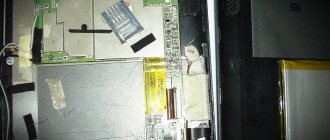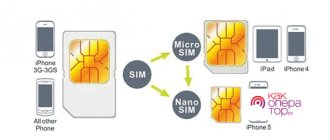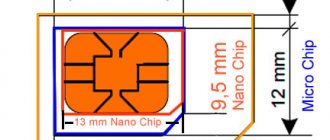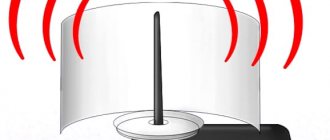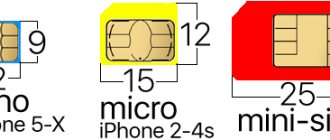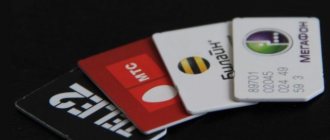Theoretically, yes, but in practice it is better not to do this. Let's see why, and also talk about the differences between SIM cards, Micro SIM and Nano SIM cards.
The photo shows SIM and Nano SIM cards. Please note their size differences. The Nano SIM card is smaller than the contact area of a regular card. Thus, if you cut a card, you will have to do it directly along the contacts.
Will she still be “alive” after this?
The chip itself inside SIM cards is tiny and is located in the center under the contact pad, at least in my card it was like this:
Therefore, when cutting the card along the contour, the chip should not be damaged. However, there are other factors due to which the card may stop working, and even worse, damage the phone.
Firstly, the foil on the contacts at the cut site may lift up or become deformed. Notice the photo of the cut card. The cut area on it (with scissors) is not at all as smooth as we would like. If deformed, some damage may occur inside the card, or it may simply not be inserted into the device.
Secondly, the pad contacts may short out due to deformation or burr formation.
Probably, we can try to prevent both of these by being especially careful when trimming, and then filing away any burrs and roughness that have arisen with a needle file or sandpaper (with fine grain). Of course, after all this, it wouldn’t hurt to carefully inspect the SIM card for short circuits.
But now the main question! Meaning? Changing a SIM card from a mobile operator takes 5 minutes. There is no charge for this. Therefore, I strongly recommend not to experiment, but simply go to the nearest office or point of sale of your operator and change the card.
Types of SIM cards
Today there are only 3 types of SIM cards, these are:
- Mini-SIM
- Micro-SIM
- Nano-SIM
Mini - sim is an ordinary and familiar SIM card, standard size, which is usually called a “SIM card”, without the “mini” prefix. The most common format of SIM cards, but today they are increasingly difficult to find in new flagship smartphone models. The size of a regular, standard SIM card or mini-sim is 25 X 15mm
Micro - sim is the same SIM card as a mini-sim, but unlike it, a micro-sim has a smaller size of 15 X 12mm. As a rule, SIM cards are sold with the ability to turn a regular SIM card into a micro-SIM card by simply squeezing a micro-SIM out of the card’s plastic frame.
A universal or multi-SIM card looks like this (you can see the boundaries along which you need to squeeze out the required SIM card size):
More about the differences
New SIM cards, in particular from Megafon, come 2-in-1. In the first photo it’s just like this. On it you can see the pressed outline of the Micro SIM. It is assumed that anyone can arm themselves with scissors and make a small card out of a large card with their own hands. In this case, “small” is a medium-sized card and to make it you won’t have to cut the contacts, so the risk of any adverse consequences is minimal.
SIM card sizes:
- SIM (Mini SIM) – 25*15*0.76 mm
- Micro SIM – 15*12*0.76 mm
- Nano SIM – 12.3 * 8.8 * 0.67 mm
The SIM we are used to now is actually a Mini SIM. Before it, the first SIM card had dimensions of 86 * 54 * 0.84 mm. This is the size of a credit card! Operators still issue SIM cards in this format. Remember, the SIM card must be broken out of such a rather large plastic “wrapper”. So, if you don’t break it out, this is the format of that very first SIM card:
Also, in the list of sizes, the most attentive probably noticed that the Nano SIM is a little thinner compared to other cards. And although the difference in thickness is very small, even this difference may turn out to be another obstacle when using a cut card (well, if someone decides to cut the Nano SIM).
What is a Nano SIM card?
Nano - sim is the newest SIM card format, and today it is the smallest SIM card size for smartphones and tablets. The Nano SIM does not have any plastic around the chip like you see on the Mini SIM and Micro SIM. The size of a nano SIM card is half the size of a standard SIM card and is 12.3 X 8.8 millimeters, which is practically the size of the chip itself, but still has a small border.
How is a SIM card cut to fit Nano dimensions?
So, the situation: a user purchases a new smartphone, tries to insert his SIM card, but it turns out that his gadget requires a nano-SIM. What ways are there to solve the problem? Alternatively, take advantage of offers from operators and buy a SIM card of the required size with a new phone number. Some operators, for example, Beeline, can reissue a valid SIM in the required format; by the way, they will do this absolutely free of charge and with the preservation of the number, tariff plan and account balance.
However, the current card stores useful information, so it would be nice to have another option for saving it. The way out in this case would be to cut the card yourself.
To implement your plan and trim a regular SIM card to nano-SIM sizes at home, you will need:
- A ruler, although a caliper would be more accurate;
- Sharp scissors (you will need to cut them out of plastic);
- Pencil or fountain pen;
- Sanding paper (preferably fine dispersion).
It is worth noting the need to take care of the safety of the information located on the SIM, because the chances of spoiling the electronic “stuffing” should not be excluded from possible events. Subscribers who do not want to take risks are advised to visit their operator’s office and apply for a SIM replacement.
The procedure for cutting a nano-SIM format SIM card from a standard size includes the following steps:
- Using a pencil or pen, mark the required dimensions on the plastic of the current SIM card. For nano-SIM they are 12.3 mm long and 8.8 mm wide. Dimensions should be noted with maximum accuracy. Of course, a caliper is preferable in this case, but you can try to get by with a ruler. Another option is to find an image with a nano-standard on the Internet, print it on a printer and transfer the dimensions to your card. For example, you can do this via a link. When marking, you need to mark the corner to be cut. This action is of particular importance due to the fact that the electronic chip contacts the device in certain areas, and it is very important to insert the card so that this contact is maintained correctly.
- Using sharp scissors (a stationery knife can also work), carefully cut the plastic along the marked lines, avoiding the possibility of going into the chip area.
- Take sanding paper (null paper is best) and remove the layer from the back side of the card to the chip level to a level of 0.67 mm (the required thickness). This requirement must be strictly observed, otherwise the chip will be damaged and the SIM card will become unusable.
Before you start cutting the existing SIM card to the required size, do not forget that such work can render the card unusable due to damage to the electronic chip. There is no way to fix anything, and all that remains is to buy a new one. Therefore, it is recommended to try to properly trim the old unnecessary card, and, if it works, start working on the current SIM card.
We recommend watching:
After this, insert the SIM card into the smartphone. If it works, then everything was done correctly. If the card does not fit into the device, then you need to either trim the edge a little or sand it thicker.
Micro-SIM and nano-SIM: the difference is in the size of the plastic or in the chip?
Based on the above characteristics of SIM cards, you can notice a significant reduction in plastic, directly along the edges of the SIM card chip. The dimensions of SIM cards are the key and main feature of what the SIM card is called. This size only affects the plastic; there are no and cannot be any changes in the chip itself. You can use a regular SIM card (mini-SIM), and if you update your smartphone to a newer model that requires a micro-SIM, you can change it to the desired size at any time, be it micro-SIM or nano-SIM.
Communication salon
The most reliable way to save your number and get a SIM card of the required type is to contact your mobile operator. The procedure involves replacing the old SIM card with a new one while maintaining the number.
The problem may be with the contacts - if they are stored on the SIM card, they will be deleted when it is replaced. In this case there are two options:
- Copy your contacts to another phone or computer in advance (instructions here).
- Find out in advance and ask the mobile phone store employees to do this.
Often this happens free of charge, but this point needs to be clarified with the specialists of the communication salon. A mandatory condition for replacing the SIM will be the provision of a passport or other document confirming the identity of the owner of the number.
How to make a nano-SIM yourself?
There are many ways to make a nano-SIM from a micro-SIM at home - there are templates for cutting on the Internet.
Photo: template example
How to make a nano-SIM:
- Trim the SIM card with thin and sharp scissors.
- Polish it with sandpaper.
Typically, nano differs from its predecessor by 0.1 millimeters. It's not noticeable, but trying to insert the card into the slot will be unsuccessful. The latest model is also as close as possible to finding the chip that is responsible for the functionality of the SIM card. This method is suitable for a person who knows how to cut plastic evenly and clearly.
Replacing a SIM card in a communication store
In both cases, the risk of damaging the chip increases, and the card may not work correctly, or even fail. The best solution would be to go to a mobile phone store with your passport and ask to change the micro-SIM to a nano-SIM. In addition, it would be nice to replace the worn out old card with a new chip. Any operator will easily and quickly change a SIM card for free or make a suitable SIM card for an iPhone or smart watch with a SIM card using the Cutter tool.
Roman Vladimirov, Apple product expert, manager of pedant.ru. Consultant for the site appleiwatch.name, co-author of articles. Works with Apple products for more than 10 years.
Approximately"
If you don’t know how to cut a SIM card under a nano-SIM with your own hands, then you can use the advice of experts. There is now a standard that all parts of these elements must meet.
The nano-SIM card has almost identical dimensions to the chip built into it. Therefore, it is enough to leave about 1.5 millimeters of plastic from the edge of the chip, and cut off the rest. Then make a small cut at an angle in the place where the SIM card has a slight deviation.
- Where the flat end of the SIM card is located, you need to leave 0.5 millimeters to the chip, cut off the rest.
- You need to leave 2 millimeters on the sides.
- Where the contact end with the cut is located, you need to leave 1.5 millimeters and do not forget to make this cut again.
Important!
The nano SIM card is 15-18% thinner than the standard model, so you will have to use a file.
Then we insert the card into the phone and if the corners do not meet somewhere, you need to sharpen them with a file. The presented method is the most common and practical.
Map template in nano standard
A simple and accurate option for properly reducing a map is to use a template. It can be downloaded and then printed. When printing, you need to set the A4 scale to 100%.
- The downloaded stencil is printed. Printing in color is not necessary, black and white is sufficient.
- A template of the required format (in our case nano) is cut out of paper.
- Using glue or double-sided regular tape (the second option is better), the template is attached to the SIM card where the logo is.
- The remaining plastic is cut off with scissors; you can also use tweezers, which must be sharp.
If you don’t have a printer, it’s enough to draw the boundaries on the product using a ruler and a regular pencil.
What to do:
- place the card so that the cut standard corner is at the bottom right;
- to the left of the chip, draw a straight line along the border, located vertically;
- From the border of the chip, on the left, retreat thirteen millimeters and draw an additional line;
- at the top of the chip, precisely along its edge, you need to draw a line horizontally;
- mark 9.5 millimeters from the top edge of the chip itself and draw a line.
The rectangle inside the lines after trimming must conform to the updated standard. You just need to make a beveled corner.
Sources
- https://mobila.guru/faqsingle/kak-obrezat-sim-kartu-pod-nano-sim/
- https://zen.yandex.ru/media/id/5ae75500256d5cf5602bba49/kak-samomu-vyrezat-microsim-i-nanosim-karty-5aeab86efd96b16361b91724
- https://justsovet.ru/hi-tech/mobilnye-telefony/kak-obrezat-sim-kartu-pod-nano-sim.html
- https://sovets.net/9033-nano-sim-karta.html
- https://DjDiplomat.ru/kak-obrezat-simku-pod-nano
- https://PhoneKZ.ru/yota/nano-simka-kak-obrezat.html
- https://tarifrus.ru/kak-obrezat-sim-kartu-pod-nano-sim/
Cutting a SIM card using a template
This is an even easier way to cut a SIM card for a nano-SIM. The procedure should be as follows:
Templates:
Template No. 1
Template No. 2
- Download and print the template.
- Carefully glue the template onto the contact part. The center of the template should coincide with the center of the contact platform.
- Using sharp scissors or a metal scalpel, carefully cut the plastic to fit the template.
- We finish it with a manicure file.
If you downloaded the second template, print it on A4. Mark the lines as shown on the template and cut out.
Cutting a SIM card using a cutter
How to cut a nano SIM card? The procedure is almost similar to the method of cutting with scissors:
- Using a cutter, cut off approximately 0.5 mm from the contact pad from a flat end.
- Carefully cut off approximately 2 mm from the flat side part.
- On the opposite side we also cut off 1.5-2 mm.
- Using scissors, carefully cut off the corner on the contact pad. This must be done on the same side where the cut corner was originally.
- Cut off 1.5-2 mm from the last uncut edge.
- We remove excess plastic from the back side with a manicure file.
- We process the curved edges with a file.
- We check the functionality.
When cutting, do not damage the contacts. Otherwise, you can throw away the SIM card.
If you doubt your abilities, contact any telecom operator salon. For 300-350 rubles they will gladly provide you with a similar service.
